
The Captain class was the designation given to 78 frigates of the Royal Navy, constructed in the United States, launched in 1942–1943 and delivered to the United Kingdom under the provisions of the Lend-Lease agreement. They were drawn from two classes of the American destroyer escort classification: 32 of the GMT (Evarts) Type and 46 of the TE (Buckley) Type. Upon reaching the UK the ships were substantially modified by the Royal Navy, making them distinct from the US Navy destroyer escort ships.

USCGC Itasca was a Lake-class cutter of the United States Coast Guard launched on 16 November 1929 and commissioned 12 July 1930. It acted as "picket ship" supporting Amelia Earhart's 1937 world flight attempt, and was the last vessel in radio contact with her as she was supposed to be reaching Howland island in the Pacific. In 1941, it was transferred to the United Kingdom and served as a convoy escort in World War II as HMS Gorleston.

The Wind-class icebreakers were a line of diesel electric-powered icebreakers in service with the United States Navy, United States Coast Guard, Royal Canadian Navy, Canadian Coast Guard and Soviet Navy from 1944 through the late 1970s. They were very effective ships: all except Eastwind served at least thirty years, and Northwind served in the USCG continuously for forty-four years. Considered the most technologically advanced icebreakers in the world when first built, the Wind-class icebreakers were also heavily armed; the first operator of the class was the United States Coast Guard, which used the vessels for much-needed coastal patrol off Greenland during World War II. Three of the vessels of the class, Westwind, Southwind, and the first Northwind all went on to serve temporarily for the Soviet Union under the Lend-Lease program, while two others were built for the United States Navy and another was built for the Royal Canadian Navy; all eight vessels were eventually transferred to the United States Coast Guard and the Canadian Coast Guard.
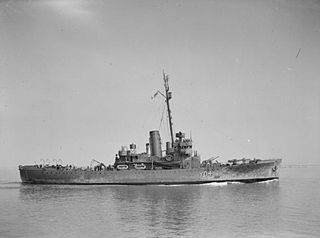
The Banff-class sloop was a group of ten warships of the Royal Navy. Built as United States Coast Guard Lake-class cutters, in 1941 these ships were loaned to the Royal Navy as antisubmarine warfare escort ships. The transfers took place at the Brooklyn Navy Yard; the sloops were manned for transport to Britain by personnel from the damaged battleship Malaya which was under repair there.

USCGC Sebago was a Lake-class cutter belonging to the United States Coast Guard launched on 12 April 1930 and commissioned on 2 October 1930. After 11 years of service with the Coast Guard, she was transferred to the Royal Navy as part of the Lend-Lease to the Allies and became HMS Walney.

German submarine U-510 was a Type IXC U-boat of Nazi Germany's Kriegsmarine during World War II, which later served in the French Navy. The submarine was laid down on 1 November 1940 at the Deutsche Werft yard at Hamburg as yard number 306, launched on 4 September 1941, and commissioned on 25 November 1941 under the command of Korvettenkapitän Karl Neitzel.

German submarine U-157 was a Type IXC U-boat of Nazi Germany's Kriegsmarine during World War II. The submarine was laid down on 21 October 1940 at the DeSchiMAG AG Weser yard in Bremen, launched on 5 June 1941, and commissioned on 15 September under the command of Korvettenkapitän Wolf Henne. After training with the 4th U-boat Flotilla, U-157 was transferred to the 2nd U-boat Flotilla for front-line service on 3 June 1942.
HMS Arabis was a Flower-class corvette of the Royal Navy. The ship was commissioned into the Royal Navy as HMS Arabis. She was transferred to the United States Navy in 1942, serving as USS Saucy. Returned to the United Kingdom in 1945, she was recommissioned into the Royal Navy as HMS Snapdragon.
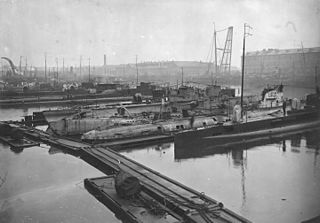
SM U-79 was one of the 329 submarines serving in the Imperial German Navy in World War I. U-79 was engaged in the combat in the First Battle of the Atlantic.

German submarine U-105 was a Type IXB U-boat of Nazi Germany's Kriegsmarine. She was ordered on 24 May 1938 as part of Germany's naval rearmament program. Her keel was laid down in Bremen on 16 November 1938. After roughly seven months of construction, she was launched on 15 June 1940 and formally commissioned into the Kriegsmarine on 10 September 1940.
HMS Goodall (K479) was a British Captain-class frigate of the Royal Navy in commission during World War II. Originally constructed as the United States Navy Evarts-class destroyer escort USS Reybold (DE-275), she served in the Royal Navy from 1943 until her sinking in 1945.
HMS Gould (K476) was a British Captain-class frigate of the Royal Navy in commission during World War II. Originally constructed as the United States Navy Evarts-class destroyer escort USS Lovering (DE-272), she served in the Royal Navy from 1943 until her sinking in 1944.
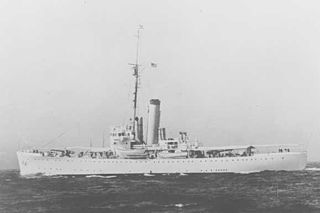
USCGC Cayuga was a Lake-class cutter of the United States Coast Guard launched on 7 October 1931 and commissioned on 22 March 1932. She was transferred to the Royal Navy where she served as HMS Totland (Y88), a Banff-class sloop from 1941 to 1946. After being returned to the USCG in 1946, she was recommissioned as USCGC Mocoma 20 March 1947.

USCGC Shoshone was a Lake-class cutter of the United States Coast Guard launched on 12 November 1932 and commissioned on 6 January 1933.

USCGC Saranac was a Lake-class cutter of the United States Coast Guard launched on 12 April 1930 and commissioned on 2 October 1930. After 11 years of service with the Coast Guard, she was transferred to the Royal Navy as part of the Lend-Lease Act.

USCGC Mendota was a Lake-class cutter belonging to the United States Coast Guard launched on 20 June 1928 and commissioned on 23 March 1929. After 12 years of service with the Coast Guard, she was transferred to the British Royal Navy as part of the Lend-Lease Act. She was sunk in January 1942 when struck by two torpedoes fired by the German submarine U-105.

USCGC Tahoe was a Lake-class cutter of the United States Coast Guard launched on 12 June 1928 and commissioned on 8 November 1928. After 13 years of service with the Coast Guard, she was transferred to the Royal Navy as part of the Lend-Lease Act.
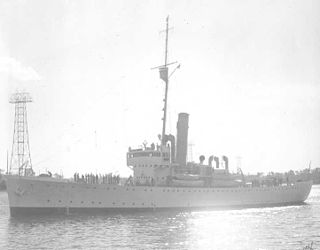
USCGC Pontchartrain was a Lake-class cutter belonging to the United States Coast Guard launched on 16 June 1928 and commissioned on 13 October 1928. After 13 years of service in the Coast Guard, she was transferred to the Royal Navy as part of the Lend-Lease Act. She was sunk in 1942 off Oran Harbor.

USCGC Chelan was a Lake-class cutter belonging to the United States Coast Guard launched on 19 May 1928 and commissioned on 5 September 1928. After 13 years of service to the Coast Guard, she was transferred to the Royal Navy as part of the Lend-Lease Act, and named HMS Lulworth (Y60). During the war Lulworth served in a convoy Escort Group for Western Approaches Command
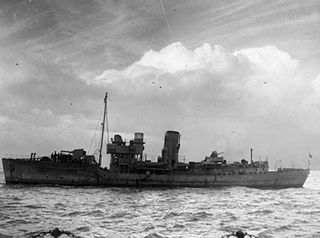
HMS Periwinkle was a Flower-class corvette, built for the Royal Navy during the Second World War, and was in service in the Battle of the Atlantic. In 1942 she was transferred to the United States Navy as part of the Reverse Lend-Lease arrangement and renamed USS Restless, one of the Temptress-class gunboats. With the end of hostilities she was returned to the Royal Navy and sold into mercantile service.
















